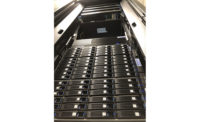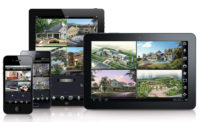Connecting an NVR to a network and sliding the physical hardware into its proper place is a big part of what security integrators and their technicians do on a daily basis. But as anyone who’s ever taken the next step knows, it’s only the beginning of a vital process — one that must be done correctly given the importance of video surveillance in security, business operations and everyday life.
“The integrator needs to marry cameras, encoders or video sources with the NVR so they know they’re assigned to it and the video is getting stored so when someone needs to see the video played back, they know exactly where to go to find the video,” says Guy Arazi, director of product management, Vicon Industries, Hauppauge, N.Y.
Exactly how an NVR is programmed depends almost solely on whether the customer wants a solution that will simply record video for potential later use or one that will be able to support multiple streams and other features.
“In general it’s going to come from customer requirements down to filtering out feature sets one by one to get to what the customer actually desires,” says Ethan Kim, product manager, Hanwha Techwin America, Ridgefield Park, N.J. “Are they really just trying to set this NVR up and be done with it and not really touch it until something happens or are they going to be doing a lot of active playback searches, incident reporting, loss prevention and so on? That’s one of the key decision factors that’s going to drive down a lot of technical factors for choosing a device.”
When configuring NVRs, understanding the network infrastructure is perhaps the most important consideration.
“One of the major issues in configuring NVRs is the installer’s knowledge of IP networking,” says Mike Tabola, senior product manager, security products, building controls and solutions, Johnson Controls, Milwaukee. “The cameras and NVR have to be on the same subnet in order for them to communicate with each other. Best practice has taught us that the cameras should be one subnet and the management of the NVR on another.”
With respect to the network, IP addressing for cameras, NVRs and other devices is an important factor. In general, IP addresses are discovered using software and then assigned via the NVR. The range of addresses should be of particular concern for integrators when programming the recorder.
“Always make sure that statically assigned addresses are outside of the DHCP range or give them a DHCP reservation,” says Chris Lim, marketing communications specialist, LTS, City of Industry, Calif. “Make sure that IP address is correct and doesn’t conflict with other devices.”
Another primary consideration for programming and configuring NVRs is how, from where and by whom the video will be accessed.
“Before programming or configuring an NVR, integrators should know if video will be accessed through a local or remote client,” says Troy Wideman, regional marketing manager, Bosch Security and Safety Systems, Fairport, N.Y. “Also, if the NVR will need to provide video or alerts to clients outside of the LAN or WAN, the integrator needs to know what network ports should be available.”
How mobile devices will be used to access and interact with the system bears careful consideration as well.
“Since a cell phone or tablet cannot process many IP streams, another system must transcode the stream before sending it to these devices,” says Ron Van Tassel, market development manager, intelligent systems, Arrow Intelligent Systems, Syracuse, N.Y. “If possible, dedicate a system for handling client viewing, analytics or the mobile device service.”
Storage Capacity
The goal of any NVR is to store video. Obviously, this must be a primary consideration for programming and configuration, with any mandated video frame rate and retention standards, coupled with a customer’s stated requirements could have significant impact on storage requirements and must be considered in the programming phase.
“For example, if there is a fixed retention requirement and fixed storage, then you’ll have to set the recorder to capture video at set frame rates, so storage and retention are not exceeded,” says Ken Maughan, product manager, recording platforms, March Networks, Ontario. “Conversely, if the customer wants video recorded at a specific frame rate, then you may need to adjust retention expectations or add more storage.”
Sometimes, these considerations are out of customers’ hands.
“In some regions or verticals, there are strict regulations on the duration, availability and integrity of video storage,” says Haitao Li, global product director for video, Honeywell Security, Melville, N.Y. “Thus features of the NVR, like IP camera front-edge backup recording and automatic backfill, NVR backup and failover, and VMS redundancy, need to be configured to meet the requirements.”
In some cases, security integrators should configure the NVR to alleviate potential issues with storage and/or bandwidth.
“Part of the installation will be configuring the NVR to perform certain actions based on external events. Examples of this would be setting an NVR to record at a lower frame rate after business hours to conserve storage capacity, or only recording video in a certain location on motion detection,” Maughan says. “These requirements are important to set correctly to ensure activities are captured as expected.”
However, this may not always be possible or even desirable. “Having a clear understanding of the expected recording schedule and which events will trigger a change in that recording is critical to ensuring events are not missed,” Maughan says. “A system that automatically records video from a camera as soon as it is added is also helpful, eliminating lost video evidence in cases where a camera is connected but not enabled or misconfigured.”
Sometimes the solution to a storage issue can actually contribute to the problem, Van Tassel says. “Will the server be required to process the motion detection or other analytic processing? This also has a big difference in CPU and memory resources required,” he says.
Scheduling can be a great way to address storage concerns — provided it is accounted for in the programming phase.
“Many times, recording schedules are not set. Then when an event occurs, no recorded video is present,” Wideman says. “After configuring cameras, the integrator needs to set them up for schedules such as continuous, motion, or event recording.”
Bandwidth Requirements
Going hand-in-hand with storage considerations is the network bandwidth factor, which can also be addressed when programming the NVR. One thing to take into account is frame rate, which can quickly add up and stress even the most advanced recorder.
“Too often an install gets hung up because the site simply doesn’t have the bandwidth to handle the amount of camera and resolution desired by the end user,” Wideman says.
In some cases, bandwidth limitation is not simply an inconvenience but is something that is mandated from above.
“Some customers will not allow large video data transfer via their corporate network, typically to avoid delays of more business-critical data,” Maughan says.
There are a number of possible solutions, such as NVRs that support alternate streams. These recorders can accommodate a stream for live viewing at a lower bit rate with lower resolution and higher compression, while also recording at full resolution and frame rate for potential investigative use later on.
“The world of video management has become pretty elaborate. A lot of features were added along the years, a lot of extracting stuff that the administrator can do or choose not to do. He has to know and get a very simple and user-friendly way to do that task,” Arazi says. “At the end of the day you’re trying to assign cameras to NVRs so you have a nice evenly distributed system. You don’t get one unit overloaded and another unit that has plenty of resources. You’re trying to find a way to do that evenly.”
Regardless of how an NVR can be — and is — programmed to reduce bandwidth strain, Mark Espenschied, director of marketing for Cerritos, Calif.-based Digital Watchdog, has a simple message for security integrators.
“Do not add more devices than the NVR can support. Do your homework regarding the capacity of the NVR and the bandwidth demands of the cameras,” he says.
Device Compatibility
Perhaps surprisingly, camera compatibility is a common issue that technicians encounter when configuring NVRs. While compatibility should be sorted out in advance of installation, it is often not done for a variety of reasons, says Maughan. These include the recorder being compatible with the most current version of a third-party camera but not an earlier generation that happens to be the version used at a customer site.
“The best way to avoid compatibility issues onsite is to ensure a clear understanding of all the camera makes, models and firmware versions that the NVR will be supporting, and confirm that those exact camera products are compatible with the recorder,” he says. “Most NVR manufacturers will have this information available online, and taking the time to verify the details is well worth the effort, eliminating unnecessary time and frustration in the field.”
Even ONVIF compliance doesn’t always guarantee compatibility between cameras and NVRs. As a result, users may select a camera because of a particular feature or set of features without knowing their chosen NVR doesn’t support those. When in doubt, says Aaron Starr, CEO, North American Cable, and president, SecurityTronix, West Chester, Pa., “Use equipment from one manufacturer or know which manufacturer’s equipment is interoperable.”
However, even with equipment from the same manufacturer, there still may be issues.
“Depending on the manufacturer, the support method may delay a little bit,” says Hanwha’s Kim. “It’s still advisable to do a little bit of research to make sure that specific features the customer is trying to use is supported by the NVR.”
There are many ways to address the proper programming and configuration of NVRs, but the human factor may be the simplest to implement, Tabola says.
“By having the knowledge of IP networking and actually installing NVRs with cameras, integrators will be in a better position to confront any issues they may encounter during the installation process,” he says.
Remember the OS
In addition to the NVR itself, there are also programming considerations within the operating system and other components. The custom settings required to have the Windows OS at optimal performance for video recording can be complex and time consuming. According to Ron Van Tassel of Arrow Intelligent Systems, at a high level there needs to be consideration on the following system programming:
- operating system settings to enhance data writes and remove unnecessary applications from the processor;
- power plans adjusted so nothing “goes to sleep;”
- bios settings;
- aero themes and other “pretty and cool” settings are off.
“Network traffic lanes are opened on the server to allow more data without CPU load,” he says.
Whatever the reason for OS configuration, this must be one of the first things a security integrator considers when diving into programming and configuring an NVR.
“There are a lot of changes that have to be made at the OS level whether for cyber security purposes or simply for performance purposes. Generally it starts at the way we configure the Windows OS,” says Jean-Pierre Picard, manager of product marketing for Montreal-based Genetec.
Tools for Success
Faced with the somewhat daunting task of undertaking the full range of NVR programming and configuration tasks, security integrators can be forgiven for any misgivings they may have. NVR and VMS providers recognize this and have created a number of tools and technologies designed to relieve the stress associated with these processes.
“Configuration at its base is a little harder in operation but it should be fairly easy and equipped with wizards and tools that will make it simple,” says Guy Arazi of Vicon.
A specific example of these tools might be a wizard that allows integrators to automatically distribute cameras across NVRs. For example, a system might comprise 500 cameras and five NVRs. It’s not enough to simply assign 100 cameras per NVR, because one recorder may be assigned 100 high-resolution cameras and another 100 low-resolution models. Instead, these tools look at the resolution and other factors of the cameras before distributing them to particular NVRs, which removes a lot of guesswork and potential frustration out of the programming and configuring process.
“You can move a camera here and there and tidy things up a bit, but 95 percent of the work is being done by simple load-balancing logic. I think that’s an incredibly strong factor,” Arazi says.
Of course, this is only one example of the type of tools integrators may have at their disposal for programming NVRs. The best advice is to take advantage of any and every helping technology available.
“Have a good set of tools — hardware and software — to assist in diagnosing problems. Some software tools to be familiar with are: PERFMON (performance monitor), resource monitor, task manager, IP scanner and GPU-Z,” says Ron Van Tassel of Arrow Intelligent Systems.
Also among the helpful tools for configuration are the front-panel LEDs some NVRs are equipped with, which let integrators know at a quick glance whether all is right with the NVR’s setup.
“These diagnostic LEDs can help confirm that an NVR has been configured properly simply by verifying that the colors are showing correctly when the NVR is turned on,” says Ken Maughan, March Networks. “They provide at-a-glance confirmation [things] are operating as they should.”
The Cyber Security Factor
No conversation about NVR programming and setup would be complete without touching on cyber security. Integrators must be diligent about changing default passwords, disabling default communication ports and more. It’s also important to make sure the NVR is running the most current firmware version.
“It’s not unusual to place a bulk order for multiple recorders in advance of installation, and if enough time has passed, that recorder may not be running the latest software version. If that’s the case, it’s important to update the NVR before the installation is complete, to patch any known bugs or vulnerabilities,” says Ken Maughan, March Networks.
Hanwha Techwin America’s Ethan Kim recommends that integrators retain that responsibility to deal with any potential issues that could possibly arise.
“It’s not an issue that we had back in the days when a firmware update could break a device, but there is still a slight chance that there could be a significant issue if your surveillance camera goes down for whatever reason; that’s not acceptable to many people,” he says. “I would still advise integrators to do firmware updates for their customers in anticipation of any unexpected downtime or incidents.”
Perhaps the best way to ensure the security of your surveillance network is to keep it separate from everything else.
“It is good practice to segment your network or even isolate the entire CCTV infrastructure,” says Georgi Pandev, technical sales manager, LATCAR, BCDVideo, Buffalo Grove, Ill. “Also, it is very common to invest in security features for areas like OS, applications, network access, etc., but overlook the firmware — BIOS, BMC, HDD, etc. — and hardware design.”
For more information about video recording, visit the following articles.



